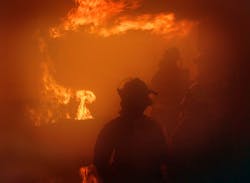Pennington: How Hot is Too Hot?
As busy summer keeps us all running around, between our kids' functions, vacations, and celebrations, we all need to stop and analyze just how hot our last structural fire was.
Being the aggressive firefighters that we are, sometimes it can get us into situations where our personal protective equipment will be pushed beyond their functioning limits. Today’s energy efficient construction may be placing you in the middle of a flashover waiting to happen. So, how do you know when you are in an environment that is getting “too hot?" What types of clues and cues does it take for you to back out?
Let’s take a look at some methods used to make sure that you are crawling into an environment that will allow you to crawl out.
Thick, black smoke: With the contents of our homes being made of plastics and other man-made materials, the smoke we are crawling into has never been this dangerous. From flashover, to rollover, to just plain old hot fires the smoke we are going into is more hostile. Knowing these simple facts should allow you to adjust for this environment. As you approach the fire building you should be searching for the rate, volume, and density of the smoke to process where the fire is and where it’s going. It should also be playing in your mind how hostile or smooth the smoke is. Smoke that presents itself with a turbulent base can be hiding fire in it!
Thick, dense, and black smoke can also render your thermal imaging camera (TIC) useless. Being so black that you will not be able to view the screen can occur. This is the reason for staying oriented to your location by other means while operating with the TIC. If the batteries were to fail or conditions worsen, you need a way of retreating.
How hot is it: Many departments use short blasting or penciling the ceiling to determine just how hot the ceiling area is. Let’s leave the choice of what to use or not use up to the chief while exploring some basic principles of its use. If you short blast the ceiling and cool water comes back down, the ceiling is at 400 degress. If you do the same technique and steam appears at the ceiling level, the temperature is between 400 to 1,000 degrees. Above 1,000 degrees steam stays up at the ceiling. Above 2,000 degrees water breaks down into is base elements and becomes a flammable mix.
These are just some basics of using this technique when entering a structure to allow you some to recognize just how hot the conditions are. If you short blast the ceiling and don’t close the nozzle down quick enough you can disrupt the thermal balance forcing a bigger heat load upon yourself. That’s why you should short blast the ceiling at different points of you attack.
Common sense: No matter what type of practice you use to measure or aseses the temperature level inside a fire you should use plain old common sense the most. If you pull up to an over-pressurized home with a small fire showing, and no victims to rescue, then vent the thing. What if you make the fire bigger or it spreads further? If you have a charged hoseline ready for attack then you will be able to keep the fire in check without committing yourself to an environment that is full of pressurized fuel!
Use common sense to size-up the situation and determine if a victim could be alive inside the structure. If not, don’t be afraid to adjust your tactics and use aggressive ventilation, and then go inside to finish the job. Risking your life to crawl into a house that is ready to flashover should not even be an option for us. If common sense tells you that you need to vent, vent. If you need to hit it from the outside, hit it from the outside. If it is too hot, stay out!
Before the comments start flowing in below about how the jumpseat guy is saying don’t go in to fires, let’s squash that right here. We do go into fires! We shouldn’t go into a flashover that is getting ready to happen. It’s a suicide mission to crawl into a superheated environment, with your ears burning, while you head should be telling you get out. If you discover that you are getting too hot don’t be afraid to come out and readjust your tactics. While the macho mentality still is among us, this jumpseat rider thinks that true courage is making the right decisions at the right time to make sure we all go home.
Thanks for the visit to the jumpseat!
